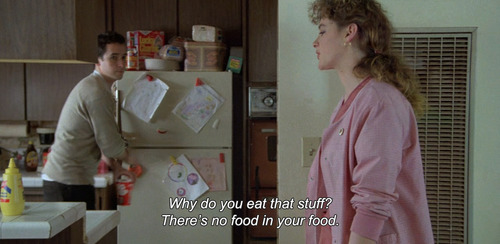The title of this post comes from one of my favorite movie quotes from one of my favorite movies (“Say Anything”), from Constance (Joan Cusak) to her brother, Lloyd (John Cusak): “Why do you eat that stuff? There’s no food in your food.”
The food in question is, of course, highly processed. But what does it mean exactly when we talk about “processed” foods? If you told me you avoid processed foods, I would ask you if you ate cheese, yogurt, bread, frozen berries, rice, oatmeal, pre-washed salad greens,coffee, tea, or anything that comes in a box, bottle, can or bag.
Because guess what? All of that is processed. This is the sort of confusion that can at times make it difficult to know how to eat for optimal health. I explored this issue in much greater depth this month in an article for Today’s Dietitian magazine, “Processed Foods: Problem or Panacea?” I interviewed a variety of experts in the field, including industry representatives, researchers, registered dietitians and other health experts.
Processed food, and the role it should/shouldn’t play in our food choices is certainly a hot topic. Many consumers are turning against Big Food the way they turned against Big Pharma. A patient recently tipped me off to an article in Fortune magazine (not my usual source of nutrition news), “The War on Big Food,” which described how food industry giants are losing ground and how they are fighting to get it back, through rebranding or other means, including buying up small health food companies. Here’s a video overview:
I liked this quote:
“The idea of ‘processing’—from ancient techniques of salting and curing—to the modern arsenal of artificial preservatives arose to make sure the food we ate didn’t make us sick. Today many fear that it’s the processed food itself that’s making us unhealthy.”
Clearly, there is a difference between:
- Processing methods that take foods from a natural, unprocessed state into a state that’s more edible (roasting or grilling meat, baking flour into bread, cooking whole grains), longer-lived (canning, fermenting, dehydrating, freezing), more appealing (roasting Brussels sprouts) or convenient (trimming and cleaning vegetables) or even more nutritious (fermenting cabbage to make sauerkraut or milk to make yogurt) using ingredients and techniques available to any home cook with time and inclination, and
- Processing methods that could never be replicated at home (making Cheetos or cold cereal*) using ingredients that are not available to the home cook (artificial colors, flavors, preservatives, industrially modified fats, and so on).
How much food is in your food?
* More on the cold cereal conundrum tomorrow.








